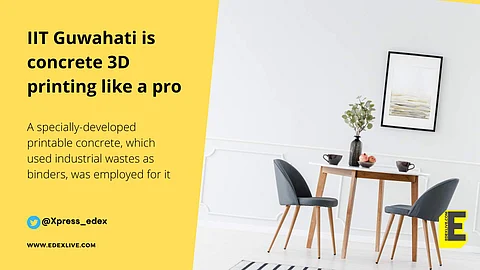

How would you like some très chic 3D-printed urban furniture that's made using construction material which, in turn, is made from local industrial waste? This is the new feat that researchers at the Indian Institute of Technology Guwahati (IIT Guwahati) have accomplished.
There is no doubt about the fact that concrete 3D printing is gaining popularity in the field of construction. Pedestrian footbridges, 3D printed modular houses, office and public school buildings and even low-cost toilet units are just a few of the recent developments from the field.
A specially-developed printable concrete, which used industrial wastes as binders, was used by researchers from the Sustainable resources for Additive Manufacturing (SReAM) at IIT Guwahati. The 3D printed furniture has a seating height of 0.4 m, a width of 0.4 m and arch-shaped support. SolidWorks and Simplify3D were used to model and slice the latter. Twenty minutes — that's the time it took to complete the cycle.
Layer by layer, the entire unit was printed at the speed of 80 mm/s and each layer had a height of 10 mm. Once printed and pre-usage, the unit was covered with moist gunny bags to cure it. This was done for seven days.
How it usually goes is that first, a mold is cast for these structures but this process not only requires more concrete material but also requires additional labour and formwork preparation. But the deal with 3D concrete printing is that the designs, which are optimised, are printed with 75 per cent less concrete, that too, sans any mold.
“We showcased how material-efficient structures can be produced in our lab-scale 3D printer. Our goal is to design high-performance concrete mixes made from industrial wastes for the printing of such complex structures,” shared Dr Biranchi Panda from the Department of Mechanical Engineering
Guess what the team is exploring next? Underwater concrete printing! Along with printing functional reinforced concrete with low carbon materials.
"3D printing of concrete can be a technological solution for reducing carbon footprint in the building and construction industry," Prof TG Sitharam, Director, IIT Guwahati said and added that, "From the Indian context, techno-economic analysis must be carried out that takes into account not only the environmental sustainability but also aspects relating to cost, quality, labour and maintenance associated with 3D printing."
It is the belief of this team that on-demand, on-site 3D concrete printing will surely have an impact that is global. It will influence versatile construction applications and multi-billion-dollar markets worldwide.
